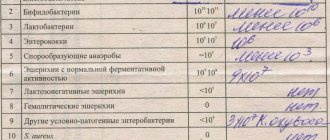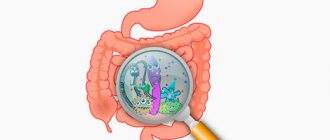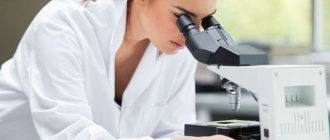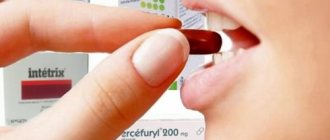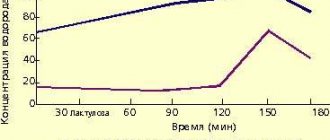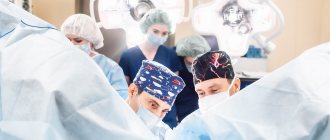What is the research used for?
- To detect bacterial dysentery, salmonellosis (including typhoid fever and/or paratyphoid fever), and escherichiosis.
- As part of the differential diagnosis (along with other studies) of infectious diseases with similar symptoms, such as diarrhea caused by viruses, protozoa or other bacteria, inflammatory bowel diseases, colon and rectal cancer, malabsorption disorders, some endocrine diseases.
- To identify bacteria carriers.
- In order to choose rational antibacterial therapy and evaluate its effectiveness.
According to Order No. 302N of the Ministry of Health and Social Development of Russia, all people who work in the production of food products or come into contact with them during transportation, sale, packaging, cooking, or cleaning premises are regularly tested for intestinal group and the results are recorded in a personal medical record book.
Microflora culture (agent identification and sensitivity to a/b)
Culture of upper respiratory tract secretions
Testing allows you to determine the causative agent of the infection and select the most effective antibiotic for treatment.
Quite often, the causes of diseases of the upper respiratory tract (in particular, rhinitis or sinusitis (nasal lesions), pharyngitis (throat mucosa)) are the effects of microorganisms:
- streptococcus, pneumococcus, staphylococcus – rhinitis;
- hemolytic (destroying red blood cells) streptococcus - pharyngitis.
Timely diagnosis with precise identification of the agent of infection facilitates adequate treatment, which in turn prevents the disease from passing from acute to chronic form.
The purpose of the study is to identify microorganisms:
main infectious agents, opportunistic bacteria:
- pneumococcus (Streptococcus pneumoniae);
- Haemophilus influenzae (Haemophilus influenzae);
- Moraxella catarrhalis;
- pyogenic streptococcus (Streptococcus pyogenes);
- Staphylococcus aureus (Staphylococcus aureus);
- gram-negative enterobacteria;
- some mushrooms of the genus Candida;
representatives of normal flora:
- viridans streptococci (Streptococcus viridans group);
- epidermal staphylococci (Staphylococcus epidermidis);
- non-pathogenic neisseria (Neisseria sp);
- non-pathogenic diphtheroids (Corynebacterium sp.);
- Candida mushrooms (Candida sp.) and others.
Bile culture
The purpose of testing is to isolate the following infectious agents:
- gram-negative bacteria of the Enterobacteriaceae family, of which Escherichia coli (Escherichia coli), Klebsiella sp., somewhat less frequently Enterobacter sp., Salmonella sp., and Proteus sp. are found;
- faecal streptococcus (S. faecalis);
- staphylococcus (Staphylococcus sp.),
- Pseudomonas aeruginosa (Pseudomonas sp.), etc.
Culture of wound fluid and tissues
The results of this testing are used to prescribe effective antibiotic treatment for wounds.
Often complex wounds are not treated properly, which in many cases is due to the inappropriate use of antibiotics.
Quite often, purulent-inflammatory complications of wounds arise due to the effects of opportunistic bacteria. However, even more common pathogens are bacteria that do not require oxygen (partially or completely) for normal functioning. The general name for such microorganisms is anaerobes. Complications of wounds are caused by some of their representatives - gram-negative (non-stainable during the characteristic Gram staining reaction) rods, gram-positive (stained) cocci, non-spore-forming rods. Even though the same symptoms of complications and the identity of the detected bacteria appear, their response to antibiotics in different people may have significant differences.
The effectiveness of antibiotic treatment currently leaves much to be desired. However, accurate identification of microorganisms and determination of their sensitivity to antibiotics makes the process much more effective.
The purpose of the study is to isolate the following infectious agents:
- pyogenic streptococcus (Streptococcus pyogenes);
- hemolytic (destroying red blood cells) streptococci of groups B, C, G;
- Haemophilus influenzae type B (Haemophilus influenzae), characteristic of cellulite;
- Pasteurella multocida, the presence of which is characteristic of complications after a bite;
- Erysipelothrix rhusiopathiae, the causative agent of an acute bacterial infection - erysipiloid, which usually affects the skin and is transmitted through contaminated animal products (one of the names of the disease is “erysipelas of pigs”);
- enterococci;
- gram-negative bacteria belonging to the Enterobacteriaceae family;
- Pseudomonas aeruginosa (Pseudomonas aeruginosa);
- Staphylococcus aureus (Staphylococcus aureus), the presence of which has been noticed in the infection of bedsores.
Important . When collecting a sample, you must have the transport medium ready.
Culture of discharge (scraping) from the eye
The study is carried out to isolate the following pathogens:
- staphylococci:
— Staphylococcus aureus (Staphylococcus aureus)
— epidermal staphylococcus (Staphylococcus epidermidis) and some other species;
- hemophilus influenzae (Haemophilus influenzae) (particular attention is paid to its presence when examining children);
- streptococci:
— pneumococci (Streptococcus pneumoniae);
— pyogenic streptococcus (Streptococcus pyogenes);
— streptococcus viridans (Viridans streptococcus);
- moraxella (Moraxella);
- Pseudomonas aeruginosa (Pseudomonas aeruginosa);
- mushrooms:
— candida (Candida) (most often);
- Escherichia coli
- Neisseria species;
— protea (Proteus vulgaris);
- corynebacteria:
— Corynebacterium xerosis;
— Corynebacterium pseudodiphtheriticum.
Sowing of genital discharge or scrapings from the vagina, cervical canal, urethra
The test is intended to identify bacteria that cause a nonspecific infectious-inflammatory disease (i.e., when the infectious agent that caused its occurrence is unknown), and to prescribe effective treatment using antibiotics based on its results.
In a normal state, the biocenosis (a set of microorganisms representing the microflora) of the human genitourinary system is represented by a more or less constant, sometimes age-dependent, composition. Thus, the vaginal microflora of women of reproductive age contains in significant quantities strict (obligate - dying when exposed to an oxygen environment) and facultative (which can exist both with and without the presence of oxygen) anaerobic organisms, most of which are lactobacilli. To a much lesser extent, it is inhabited by aerobic (requiring normal oxygen content for life) and microaerophilic (which require a reduced oxygen concentration) opportunistic bacteria. In the internal canal of the cervix and in the uterus itself, bacteria are normally absent.
The microflora of girls who have not entered the puberty phase is represented by cocci and diphtheroids (Gram-positive rods).
Small amounts of gram-positive rods and cocci may be present in the parts of the urethra (urethra) of healthy men closest to the external outlet. The proximal (distant from the exit) parts of the urethra, prostate and seminiferous tubules are normally sterile.
If the balance between the types of microorganisms is disturbed and/or bacteria unusual for a given place appear, this creates a serious precondition for the occurrence of an infectious-inflammatory process.
Diseases typical for women:
- vaginitis – inflammation of the vaginal mucosa;
- urethritis - inflammation of the urethra;
- Cervicitis is an inflammation of the cervix or the uterus itself.
Diseases common in men:
- urethritis - inflammation of the urethra;
- prostatitis – inflammation of the prostate gland.
The result of the study is the isolation of opportunistic bacteria (i.e. those that can be part of the normal microflora, but when the immune system is weakened they become pathogens): enterobacteria, streptococci, staphylococci, Haemophilus influenzae, non-fermentative gram-negative bacteria, enterococci, coryneform bacteria, yeast-like mushrooms (only the fact of their presence is stated, the species are not determined).
Attention! A study of the presence of specific pathogens - chlamydia (Chlamydia trachomatis), trichomonas vaginalis (Trichomonas vaginalis), pale spirochete (Treponema pallidum), gonococcus (Neisseria gonorrhoeae) is not carried out as part of this test.
Culture of ear discharge
This test is intended for microbiological diagnosis of purulent-inflammatory diseases of the ear.
Purulent-inflammatory processes differ in localization and can be caused by various pathogens. The lesion is classified according to the location of the source of the disease:
- ear canal (boils, diffuse lesions);
- eardrum (this disease is called myringitis);
- middle ear;
- mastoid process (mastoiditis).
The following microorganisms cause diseases:
- Staphylococcus aureus – otitis media, boils;
- gram-negative rods – diffuse lesions;
- streptococcus – inflammation of the eardrum (myringitis);
- microplasma – inflammation of the eardrum;
- gram-negative Escherichia coli – inflammation of the middle ear.
For a quick recovery of the patient, as well as to prevent the transition of the disease from acute to chronic, it is very important to identify the pathogen and determine its sensitivity to antibiotics.
Cultures are carried out to check for the presence of gram-negative bacteria belonging to the family Enterobacteriaceae, Pseudomonas aeruginosa, staphylococci, streptococci (S. pyogenes, S. pneumoniae, S. viridans), corynebacteria, yeast-like fungi, Haemophilus influenzae ).
Culture of puncture material
The purpose of culture is to isolate the following pathogens:
- representatives of the enterobacteria family, namely Escherichia coli (E. coli), Klebsiella sp, species of enterobacter spp, Proteus sp and some others;
- fecal streptococcus (Streptococcus faecalis);
- Pseudomonas aeruginosa (Pseudomonas aeruginosa);
- staphylococci, streptococci;
- yeast-like fungi;
- hemophilus influenzae (Haemophilus influenzae) - it is rare, mainly with infectious arthritis in children.
Samples taken for research:
- aspiration (selected by vacuum) fluid from the peritoneum or pleura;
- synovial fluid - a thick substance that fills the cavities of the joints;
- pericardial fluid - serous fluid located in the pericardial sac;
- amniotic fluid - amniotic fluid.
Sowing for anaerobic microflora
The purpose of the study is to detect the presence of microorganisms living and growing without access to oxygen during purulent-inflammatory processes.
Anaerobic bacteria live safely in the human body, making up a significant part of its microflora. However, certain conditions can make them the cause of purulent inflammation.
Regardless of what part of the body the focus is located, the action of anaerobes is not varied - this is rotting and gas formation. Most often, the target of microorganisms is the organs in which they live, resulting in damage to the genitourinary system, gastrointestinal tract, and upper respiratory tract. Carrying out an accurate diagnosis is vital - only this will help prescribe adequate treatment and neutralize the infection, which poses a mortal danger to the human body.
The infection is caused by prevotella, veillonella, clostridia, propionobacteria, eubacteria, peptostreptococci, actinomycetes, fusobacteria, gemella, bifidobacteria, bacteroides, porphyromonas.
During the examination, testing is carried out:
- aspirate (liquid with cells of the epidermis - the outer layer) from body cavities;
- biological fluids from the peritoneal cavity and pleura;
- purulent contents of abscesses;
- pieces of tissue due to inflammation of skeletal muscles (myositis) or tissue necrosis (myonecrosis - gas gangrene);
- discharge from the bottom of ulcers;
- bile;
- prostate secretion (seminal fluid).
When is the study scheduled?
- if you suspect acute or chronic bacterial dysentery, salmonellosis or escherichiosis;
- when examining persons who have been in contact with bacteria carriers or who have had dysentery, salmonellosis (including typhoid fever, paratyphoid fever), escherichiosis or other intestinal infections of unknown origin during the last year;
- during outbreaks of acute intestinal infections, especially in “closed” groups;
- as a preventive examination of persons before hospitalization;
- when applying for employment in a child care facility, food service, or medical facility.
How to properly prepare for research?
Preparation for taking this test is exactly the same as for testing for dysbacteriosis.
- the study is recommended to be carried out before starting antibiotics and other antibacterial chemotherapeutic drugs;
- exclude the use of laxatives, the introduction of rectal suppositories, oils, limit (in consultation with the doctor) the use of medications that affect intestinal motility.
Who should be tested for intestinal group?
If symptoms of the disease are present, all patients should be tested. During and after treatment, the study will need to be repeated at least three times to be sure of the absence of bacterial carriage and safety for your family and work team members.
For preventive purposes, they are compulsorily tested (they are suspended from work if the study is not carried out):
- medical workers in children's and infectious diseases departments, maternity hospitals;
- staff of preschool institutions and schools, summer camps;
- food workers (cooks, waiters);
- people by profession associated with the production and processing of products, packaging, transportation (workers of dairy plants, bakeries, culinary shops, etc.);
- people who sell products in stores and markets (sellers, meat cutters).
Citizens are received from Monday to Friday at the address: Naberezhnye Chelny, Nizametdinova St., 14, at the reception on the 1st floor from 8.00. until 10.00.
Results are issued from Monday to Friday at the registration desk from 12.30. until 15.00.
You can get detailed information by calling a specialist by phone.
The article was helpful! Let others know! ?
Do you have a question? Write to us!✍
Share link:
- Seal
- Telegram
How to take a urine test for tank culture
Often, patients have to re-take a culture test because the results are distorted; as a rule, this is due to improper urine collection. You should prepare a sterile container in advance; you can buy a container for collecting urine at the pharmacy.
Two days before the delivery of the culture tank, you should stop using diuretics and other pharmacological drugs. In addition, the patient should exclude carrots, beets and other foods that can change the color of urine from the menu. Before collecting urine, perform genital hygiene. For culture analysis, the middle part of the urine is collected.
The effectiveness of diagnostics depends on how quickly the test material is delivered to the laboratory. After 3 or more hours, the information content decreases significantly. In summer, urine should not be stored for more than 1-2 hours. The laboratory will conduct tests and observe the growth of bacteria in the urine; this is a long procedure, so the result is usually ready no earlier than in 5-10 days.
To take a urine test for culture, please contact the President-Med medical centers
